Indoor air quality perception: Enablers and inhibitors of perceived occupant comfort
IF 10.3
1区 环境科学与生态学
Q1 ENVIRONMENTAL SCIENCES
引用次数: 0
Abstract
Growing environmental and public health concerns have increased the need for healthy buildings, with indoor air quality (IAQ) emerging as a priority. While technological advancements in IAQ management have progressed, research often overlooks individual comfort perception and behavioral factors influencing it and disconnects IAQ improvements from behavioral insights. This study explores how personal characteristics, perceived inhibitors, and enablers shape comfort perception in indoor environments managed by Internet of Things-based IAQ management technologies (IAQMTs). Given the EU’s growing emphasis on smart, energy-efficient, and occupant-centered buildings, we examine comfort perceptions across seven European countries to inform user-centered IAQ strategies aligned with policy goals. Grounded in the dual-factor theory, we employed a survey-based approach in the European context and analyzed responses from 2800 individuals using partial least squares structural equation modeling (PLS-SEM). Our model demonstrated strong explanatory power, accounting for over 65 % of the variance in perceived IAQ and comfort in public environments. Key enablers are intuitiveness, response efficacy, and hedonic motivation, while convenience is not. Information and privacy concerns are not inhibitors. Health consciousness and environmental consciousness are important individual characteristics when it comes to perception. Perceived good IAQ was the strongest predictor of comfort in public spaces. The findings emphasize the importance of intuitive, transparent, and engaging IAQMTs that visibly demonstrate pollutant reduction and comfort enhancement. We recommend that building managers and technology developers incorporate user-centered features, such as clear interfaces, gamification elements, personalized controls, and communication strategies highlighting health and environmental benefits, to foster adoption and improve occupant comfort. Our findings support a human-centered approach, integrating behavioral insights into environmental health science, focusing beyond technical metrics and more on occupant beliefs and perceptions, supporting strategies that align with user needs and EU goals.
室内空气质量感知:感知乘员舒适度的促进因素和抑制因素
日益增长的环境和公共卫生问题增加了对健康建筑的需求,室内空气质量(IAQ)成为优先事项。虽然室内空气质量管理的技术进步取得了进展,但研究往往忽视了个人的舒适感知和影响它的行为因素,并将室内空气质量的改善与行为洞察力脱节。本研究探讨了在基于物联网的室内空气质量管理技术(iaqmt)管理的室内环境中,个人特征、感知的抑制因素和促进因素如何塑造舒适度。鉴于欧盟对智能、节能和以居住者为中心的建筑的日益重视,我们研究了七个欧洲国家的舒适度,为符合政策目标的以用户为中心的室内空气质量战略提供信息。在双因素理论的基础上,我们在欧洲背景下采用了基于调查的方法,并使用偏最小二乘结构方程模型(PLS-SEM)分析了2800名个体的反应。我们的模型显示出很强的解释力,占公共环境中感知室内空气质量和舒适度差异的65% %以上。关键的促成因素是直观性、反应效能和享乐动机,而便利性则不是。信息和隐私问题不是阻碍。在感知方面,健康意识和环境意识是重要的个体特征。良好的室内空气质量是公共空间舒适度的最强预测指标。研究结果强调了直观、透明和引人入胜的iaqmt的重要性,这些iaqmt可以明显地显示出污染物的减少和舒适度的提高。我们建议建筑管理人员和技术开发人员结合以用户为中心的功能,如清晰的界面、游戏化元素、个性化控制以及强调健康和环境效益的沟通策略,以促进采用并提高居住者的舒适度。我们的研究结果支持以人为本的方法,将行为洞察融入环境健康科学,超越技术指标,更多地关注居住者的信念和看法,支持与用户需求和欧盟目标一致的战略。
本文章由计算机程序翻译,如有差异,请以英文原文为准。
求助全文
约1分钟内获得全文
求助全文
来源期刊

Environment International
环境科学-环境科学
CiteScore
21.90
自引率
3.40%
发文量
734
审稿时长
2.8 months
期刊介绍:
Environmental Health publishes manuscripts focusing on critical aspects of environmental and occupational medicine, including studies in toxicology and epidemiology, to illuminate the human health implications of exposure to environmental hazards. The journal adopts an open-access model and practices open peer review.
It caters to scientists and practitioners across all environmental science domains, directly or indirectly impacting human health and well-being. With a commitment to enhancing the prevention of environmentally-related health risks, Environmental Health serves as a public health journal for the community and scientists engaged in matters of public health significance concerning the environment.
 求助内容:
求助内容: 应助结果提醒方式:
应助结果提醒方式:


